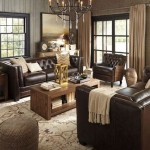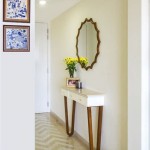How to Decorate a Room With Dark Paneling Walls
Dark paneling walls can lend a sense of sophistication, warmth, and historical character to a room. However, decorating around such a dominant feature requires careful consideration. A successful design strategy will balance the inherent intensity of the dark paneling with elements that brighten, complement, and provide visual interest. This article provides a guide to navigating the challenges and opportunities presented by dark paneled walls, focusing on key areas such as color palette, lighting, furniture selection, and accessory choices. The goal is to transform a potentially gloomy space into a stylish and inviting room.
Understanding the Characteristics of Dark Paneling
Before embarking on a decorating project, it is crucial to assess the existing paneling. Consider the type of wood used, its condition, and the specific shade of darkness. Different wood types will have unique grain patterns and undertones that can influence the overall aesthetic. For example, walnut paneling will likely have warmer reddish-brown undertones compared to oak which could lean towards cooler or golden tones. The finish on the paneling also matters. A high-gloss finish will reflect more light, while a matte finish will absorb it, impacting the perceived brightness of the room. Furthermore, the style of the paneling, whether it is traditional raised panel, wainscoting, or more modern flat paneling, will dictate the overall architectural feel of the space. Taking time to understand these characteristics is essential for creating a cohesive and harmonious design.
The existing condition of the paneling is another important factor. Damaged or poorly maintained paneling can detract from the room's overall appearance. Before decorating, address any necessary repairs, such as filling cracks, repairing loose panels, or refinishing the wood. While painting dark paneling is an option, it significantly alters the original character of the room and should be considered carefully. If the paneling is in good condition, preserving its natural beauty is often the most desirable approach.
Selecting a Complementary Color Palette
Choosing the right color palette is paramount when decorating a room with dark paneling. The goal is to create a balance between the darkness of the walls and the need for brightness and visual interest. Light and airy colors are often the best choice for offsetting the intensity of the paneling, but they are not the only option. The key is to select colors that harmonize with the undertones of the wood and the overall desired aesthetic of the room.
Neutral colors, such as off-white, cream, beige, and light gray, are classic choices for rooms with dark paneling. These colors reflect light and create a sense of spaciousness, preventing the room from feeling too enclosed or gloomy. Consider using varying shades of these neutrals to add depth and dimension to the space. For instance, pair off-white walls with cream-colored trim and beige furniture. Linen textures, such as linen curtains and upholstery, can add another layer of visual interest to neutral backdrops.
While lighter colors are generally recommended, bolder colors can also be incorporated strategically. Jewel tones, such as emerald green, sapphire blue, and ruby red, can create a dramatic and luxurious look when paired with dark paneling. However, it is important to use these colors sparingly and balance them with lighter elements. For example, an emerald green velvet sofa can be balanced with light-colored rugs and accent pillows. Another option is to use deep, muted colors, such as charcoal gray, navy blue, or forest green, to create a cohesive and sophisticated atmosphere. These colors are especially well-suited for creating a library or study setting.
Accent colors can be introduced through artwork, accessories, and textiles. Consider using pops of bright colors, such as sunny yellow, coral, or turquoise, to add energy and visual interest to the room. These colors can be incorporated through throw pillows, artwork, lampshades, and other decorative items. Alternatively, metallic accents, such as gold, silver, or bronze, can add a touch of glamour and sophistication. Metallic frames, lamps, and decorative objects can reflect light and create a sense of warmth and luxury.
Maximizing Light and Illumination
Adequate lighting is crucial in any room, but it is especially important when dealing with dark paneling. Dark walls absorb light, which can make the room feel dim and cramped if not properly illuminated. A multi-layered lighting scheme that incorporates ambient, task, and accent lighting is essential for creating a bright, inviting, and functional space.
Ambient lighting provides overall illumination for the room. Chandeliers, pendant lights, and recessed lighting are all effective options for ambient lighting. When choosing fixtures, consider the style of the room and the height of the ceiling. A grand chandelier can add a touch of elegance to a formal living room or dining room, while a simple pendant light can provide a more modern and understated look. Recessed lighting is a good option for rooms with lower ceilings, as it provides illumination without taking up too much visual space.
Task lighting provides focused illumination for specific activities, such as reading, writing, or cooking. Table lamps, floor lamps, and desk lamps are all common forms of task lighting. Place task lighting in areas where it is needed most, such as near a reading chair, a desk, or a kitchen countertop. Consider using lamps with adjustable arms or dimmers to customize the lighting to your specific needs.
Accent lighting highlights specific features of the room, such as artwork, architectural details, or decorative objects. Spotlights, track lighting, and wall sconces are all effective options for accent lighting. Use accent lighting to emphasize the most attractive features of the room and create visual interest. For example, use spotlights to illuminate a valuable painting or sculpture, or use wall sconces to highlight the architectural details of the paneling.
Beyond artificial lighting, natural light is also a crucial consideration. Maximize the amount of natural light entering the room by keeping windows clean and unobstructed. Use sheer curtains or blinds that allow light to filter through while still providing privacy. Mirrors can also be used to reflect natural light and create a sense of spaciousness. Place mirrors strategically to maximize their reflective potential, such as across from a window or near a light source.
Selecting Furniture and Accessories
The furniture and accessories chosen for a room with dark paneling should complement the existing architecture and enhance the overall design aesthetic. Consider the scale, style, and color of the furniture to create a balanced and harmonious space.
When selecting furniture, opt for pieces that are lighter in color and scale to balance the darkness of the walls. Light-colored sofas, chairs, and tables will stand out against the dark paneling and create a sense of contrast. Consider using furniture with clean lines and simple silhouettes to avoid overwhelming the space. Upholstered furniture in natural fabrics, such as linen or cotton, can add a touch of texture and warmth. Glass-topped tables and acrylic chairs can also help to lighten the space and create a sense of openness.
Rugs can play a significant role in defining the space and adding warmth and texture to the room. Opt for rugs that are lighter in color and pattern to contrast with the dark paneling. Consider using rugs with geometric patterns, floral motifs, or abstract designs to add visual interest. Natural fiber rugs, such as sisal or jute, can also add a touch of texture and warmth.
Artwork and accessories provide an opportunity to personalize the space and add pops of color and visual interest. When selecting artwork, consider the size, style, and color of the pieces. Large-scale artwork can make a statement and create a focal point in the room. Choose artwork that complements the color palette and enhances the overall design aesthetic. Metallic frames can add a touch of glamour and reflect light, while colorful artwork can add energy and vibrancy. Accessories, such as throw pillows, vases, and decorative objects, can also be used to add personality and visual interest. Choose accessories that complement the color palette and enhance the overall design aesthetic.
Plants can also bring life and vibrancy to a room with dark paneling. Greenery will contrast beautifully with the dark wood, adding a touch of freshness and natural beauty. Consider using a variety of plants in different sizes and shapes to create a layered and dynamic display. Place plants near windows to maximize their access to natural light. Hanging plants, potted plants, and floor plants can all be used to create a lush and inviting atmosphere.

How To Create A Fresh Look In Room With Dark Wood Paneling

Our Guide On Decorating A Room With Dark Paneling What To Know Timber2udirect

How To Make A Dark Paneled Room Look Fresh Light Designed House And Home Interior New England Homes

How To Decorate Around Dark Wood Paneling

87 Hallway Ideas To Make A Great First Impression Wood Paneling Decor Panel Walls

10 Rooms That Take Wood Paneling To The Next Level Architectural Digest

How To Make Wood Paneling Look Modern Without Painting It Five Ways

How To Make A Dark Paneled Room Look Fresh Light Designed Interior Design House

Wall Panelling Ideas I Love

Moving To A Place With These Wood Paneled Walls What Color Kind Of Decor Matches Not Our Stuff In S R Homedecorating







